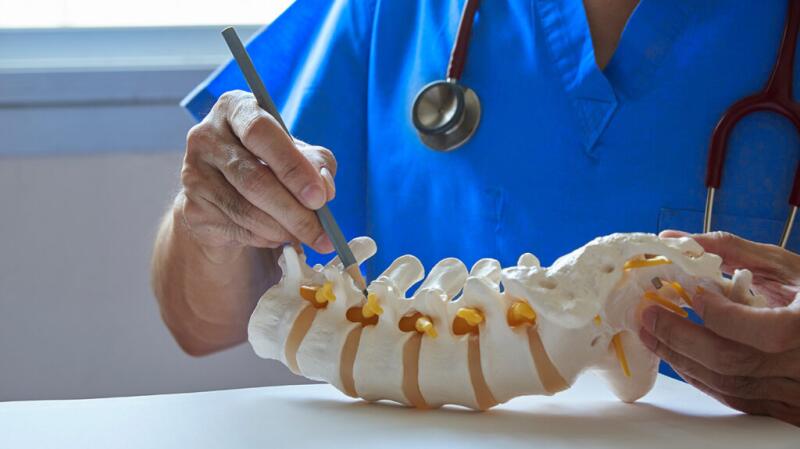17 Nov 2025
Cognitive Rehabilitation & Brain Training Programs Amritsar


Dr. Vineet Saggar
22 Jun 2025
Call +91 80788 80788 to request an appointment.
Lumbar disc surgery is a crucial treatment option for patients suffering from debilitating back issues due to problems with their lumbar discs. These discs serve as shock absorbers between the vertebrae in the lower back and can become damaged due to injury, degeneration, or age-related changes. At Livasa Hospitals Mohali, we specialize in advanced spine treatment to help patients regain mobility and relieve pain. Understanding the causes and symptoms of lumbar disc problems is the first step toward making informed decisions about treatment options.
The lumbar spine consists of five vertebrae, which support the weight of the upper body and allow for a wide range of movements, including bending and twisting. Each vertebra is separated by intervertebral discs that cushion the vertebrae and absorb impacts. Over time, these discs can become herniated or degenerate, leading to conditions such as lumbar disc disease, which can cause significant pain and discomfort.
Lumbar disc issues can arise from various factors, including:
Symptoms of lumbar disc problems often vary depending on the location and severity of the condition. Common symptoms include:
Diagnosis typically involves a thorough medical history review, physical examinations, and imaging tests like MRI or CT scans to provide detailed images of the spine.
Before considering surgical options, various non-surgical treatment methods can help alleviate symptoms:
Surgery is often considered when conservative treatments fail to provide relief, particularly in cases of severe pain or neurological symptoms such as weakness, numbness, or bowel and bladder dysfunction. At Livasa Mohali, we determine the necessity of surgery through careful assessments and diagnostic imaging.
There are various surgical procedures for treating lumbar disc issues, each with its indications and benefits:
| Procedure Type | Overview | Recovery Time |
|---|---|---|
| Discectomy | Removal of the herniated disc material pressing on a nerve. | 1-2 weeks for minimal restrictions. |
| Laminectomy | Removal of the lamina to relieve pressure on the spinal cord. | 3-4 weeks for full recovery. |
| Artificial Disc Replacement | Replacement of the damaged disc with an artificial one. | 4-6 weeks; faster recovery than fusion. |
| Spinal Fusion | Joining two or more vertebrae for stabilization. | 3-6 months; longer recovery due to fusion process. |
Recovery from lumbar disc surgery varies depending on the type of procedure performed. Post-operative care and rehabilitation are essential to ensure successful healing and restoration of spine function. This may involve:
Lumbar disc surgery generally has a high success rate, with many patients experiencing significant relief from pain and improved function. According to recent studies, over 80% of patients report positive outcomes and improved quality of life following surgery. However, outcomes can vary based on individual conditions and adherence to rehabilitation processes.
At Livasa Hospitals, we emphasize personalized care to maximize each patient's potential for success. Our multidisciplinary approach ensures that every aspect of recovery is monitored and managed effectively.
Livasa Hospitals is recognized as one of the best spine centers in Punjab, providing cutting-edge spine treatment tailored to meet each patient's unique needs. With a team of experienced surgeons and state-of-the-art facilities, we ensure a comprehensive approach to spinal health. Our commitment to patient education and support guarantees that you are equipped to make informed decisions regarding your treatment.
If you are facing lumbar disc issues, do not hesitate to reach out to us. We believe that early intervention can make all the difference.
Your journey to freedom from back pain begins with a consultation. Book your appointment at Livasa Hospitals Mohali or call us at +91 80788 80788 to speak with our specialists about your treatment options.
Neurotropic Virus Infections: West Nile, Zika, Japanese Encephalitis Amritsar
+91 80788 80788
Livasa Healthcare Group Corporate Office,Phase-8, Industrial Area, Sector 73, Sahibzada Ajit Singh Nagar, Punjab 160071
livasacare@livasahospitals.in
| Mohali | +91-99888 23456 |
| Amritsar | +91-99887 49494 |
| Hoshiarpur | +91-99883 35353 |
| Nawanshahr | +91-75081 82337 |
| Khanna | +91-98888 05394 |